|
< Back
Next > |

One of
the most sought after star patterns
on American flags is the "Grand
Luminary" or "Great Star" pattern,
which consists of the smaller stars being arranged to form one great
star on the canton. The
pattern was designed by Captain
Samuel Chester Reid of the United
States Navy in 1818.
The task set upon by Captain Reid
was to design a pattern that would
allow for increasing the number of
stars on the flag, yet maintain a
common distinctive pattern on the
flag. While the concept was
intriguing and resulted in some of
the most interesting and beautiful
flags known today, the design was
not officially adopted by Congress.
Great Star patterns were made from
the early 19th century, and were a
favorite design during the Civil
War, but their use tapered off
following the Civil War as the star
counts began to make even the Great
Star unwieldy, and they all but
disappeared from manufacture by the
late 19th century.
Below
are some examples of the Grand
Luminary pattern. The pattern
appears on both printed parade flags
and those of traditional pieced and
sewn construction.
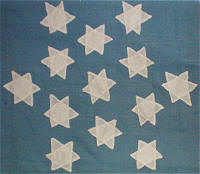 |
13 Stars, 1860-1880.
This single-sided homemade
flag likely dates to the
period of the Civil War to
the Centennial. The
six-pointed great star
pattern is known on only a
small handful of sewn flags,
and I am only aware of two
sewn flags where the
six-pointed great star is,
itself, made of smaller
six-pointed stars. The
emblem is representative of
the star configuration on
the Great Seal of the United
States, which consists of a
six-pointed star made of
smaller six-pointed stars. |
 |
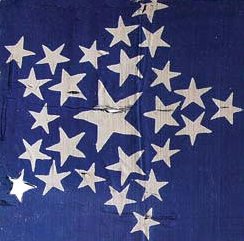 |
26 Stars, 1837-1845.
This silk flag of 26 stars
is one of the earliest
printed parade flags known.
The pattern is intriguing
because of its use of
various size stars and the
folky arrangement.
Most likely, there are fewer
than ten of this particular
manufacture that have
surfaced. Flags with 26
stars, of the pre-Civil War
period, are rare. The
flag celebrates Michigan
statehood. This
particular flag descended in
the family of Admiral
Stephen Decatur.
|
 |
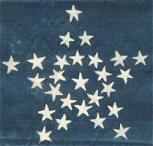 |
26 Stars, 1836.
This small hand sewn silk
parade flag with 26 painted
stars is a tiny survivor
from the early 19th century.
It was sewn in 1836 by Ms.
Mary R. Blair, just prior to
the admission of Michigan as
the 26th state on January
26, 1837. This is the
smallest sewn flag dating
from the first half of the
19th century that I've
encountered. Note the
whimsical style of the hand
painted stars. |
 |
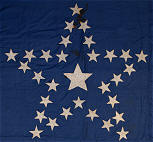 |
31 Stars, 1850-1858.
This flag made for
California statehood
pre-dates the Civil War, and
is a rare survivor, being a
homemade flag made entirely
of fragile mid-19th century
cotton fabric. The great
star stands straight and
proud on the canton, and
surrounds a large center
star representing
California. |
 |
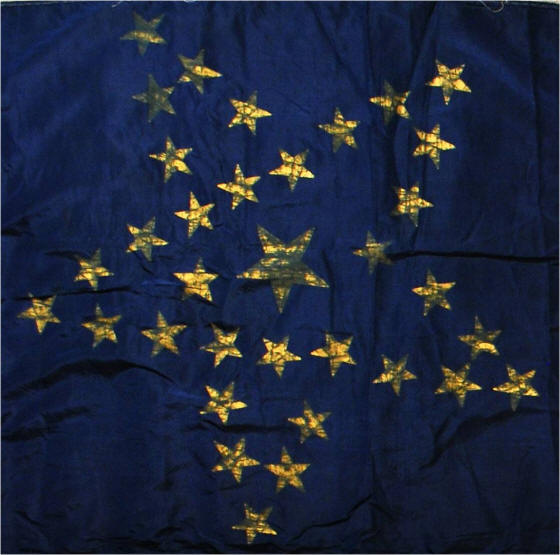 |
34 Stars, 1861-1863.
This silk flag of 34 stars
is the company battle flag
for Company L, 102nd
Pennsylvania Volunteer
Infantry (originally Company
C, 13th Pennsylvania
Volunteers). Descended
in the family of the company
commander, it is
exceptionally rare.
The flag shows clear
evidence of being carried in
the field. One can
Imagine its beautiful gilt
stars, deep blue canton,
stripes and silk fringe
waving in the breeze on the
battlefield among the ranks
of the Union infantry. |
 |
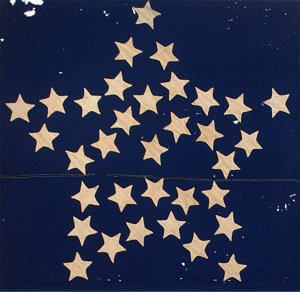 |
34 Stars, 1861-1863.
This beautiful 34 star Great
Star flag was located in
central New York, near
Rochester. Though the
specific history of the flag
is not known, it dates to
the opening years of the
Civil War, 1861-1863, and is
in a wonderful state of
preservation.
The puffy, hand sewn
double-appliqué stars and
unusual arrangement of the
inner stars within the great
star make this a charming
representation of this very
rare pattern. |
 |
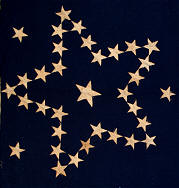 |
34 Stars, 1861-1863.
This exceptional Great Star
flag, made during the
opening years of the Civil
War, has several striking
features, including three
outlier stars, a large Great
Star where the star is
precisely outlined rather
than crossing the center of
the star, and the rare trait
of a large Center Star in
the middle of the Great
Star, with its arms
precisely pointed to the
inner corners of the Great
Star. It's made of very fine
quality woven wool blend
rather than looser, coarser
wool bunting. |
 |
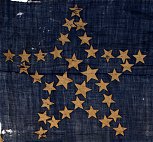 |
34 Stars, 1861-1863.
An excellent example of the
type, this flag the unique
trait of four large center
stars. Though the
meaning of this arrangement
is not known for certain, it
quite possibly symbolizes
the four "Border States" of
Maryland, Delaware, Kentucky
and Missouri, where
loyalties were split between
the North in some regions,
and the South in others.
This Great Star flag could
represent the desire to keep
these important states
firmly part of the Union. |
 |
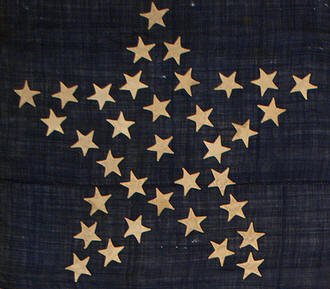 |
35 Stars, 1863-1865.
This classic Civil War Grand
Luminary Flag was produced
at the height of the Civil
War and is a great
reaffirmation of the Union
that Americans were fighting
to preserve.
Constructed of sewn cotton
stars on wool bunting, the
flag's colors remain rich
and vivid today. |
 |
 |
37 Stars, 1867-1877.
An extremely rare pattern
for a sewn flag, this 37
star flag combines the
medallion pattern style,
with a large wreath and four
corner stars, with the
"grand luminary" or "great
star" pattern on a single
flag. It is the only
sewn flag that I'm aware of
that so clearly combines
these two great styles of
early American flags. |
 |
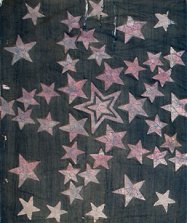 |
43 Stars, Originally 36
Stars. 1865-1890.
One of the latest period
Grand Luminary flags known,
this flag with its white
painted stars shows evidence
why the pattern began to
become impractical. In
order to fit all of the
stars on the flag, the maker
intentionally moved some of
the stars to the spaces
between the great star's
arms. Taken in
combination, the various
aspects of the flag--stars
of varying sizes, stars
rotating on their axes, the
"haloed" central star, the
tilted great star, the
sprinkling of stars between
the arms--all add to one of
the most exuberant,
celebratory expressions one
can find on an American flag
of any period. Five
large outlier stars are
original to the flag, but
seven smaller outliers were
added circa 1890, bringing
the total from 36 original
stars to 43 stars. |
 |
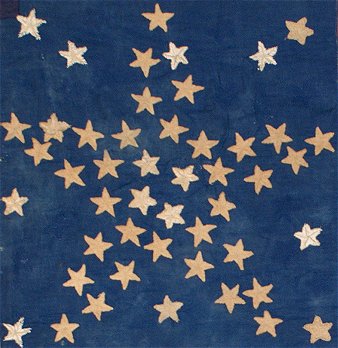 |
48 Stars, Originally 35
Stars. 1863-1959.
This wonderful homemade
Great Star flag originally
began its life with 35
stars, born in the middle of
the American Civil War.
Over the course of many
decades, the flag was
repeatedly updated to
eventually arrive at 48
stars. This is the
highest star count for a
Great Star flag that I've
ever encountered. The
hand embroidered stars are
extremely folky, and
although they're all
similarly constructed, it's
clear that the updates to
the stars were done by at
least one, and most likely
several, different hands from
those of the original maker
of the flag. |
 |
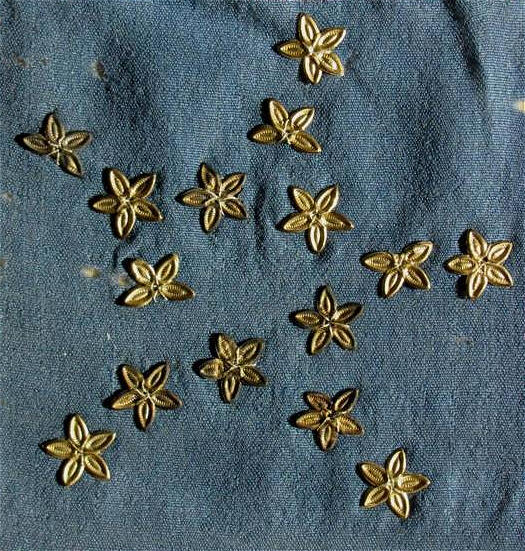 |
15 Stars, 1861.
The only Grand Luminary
pattern I've ever
encountered on a flag of the
Confederacy, the beautiful
pattern of gold foil stars
affixed to the canton
harkens back stylistically
to the earliest Grand
Luminary patterns of the
early 19th century. |
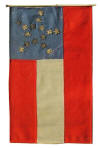 |
|
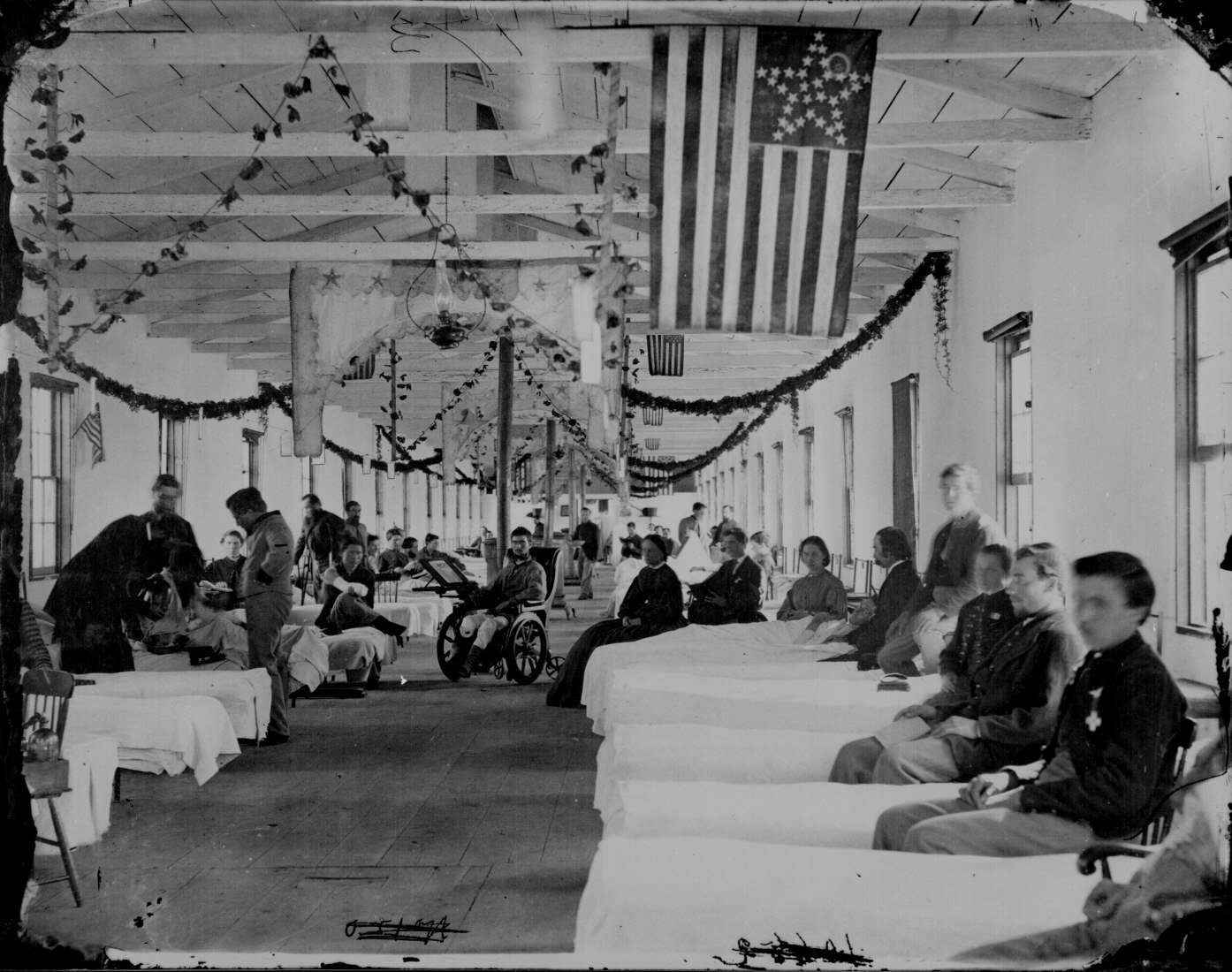
Union soldiers
convalesce at a Civil War hospital under a Great
Star flag. Other flags, some with
medallions, can be seen hanging in the
background.
|
 |
Next:
Medallion Pattern Flags |
 |
|
|
Except where cited otherwise, all content
© 2010 by Anthony Iasso
|
|
|
|
|

